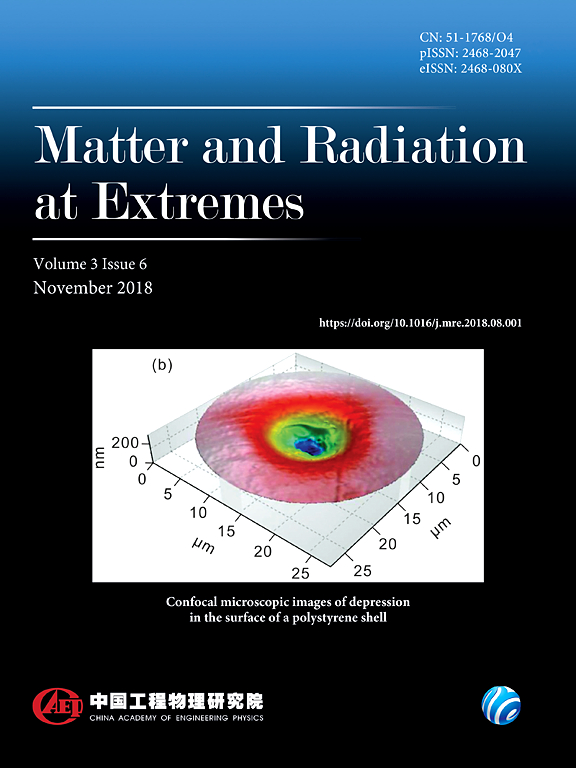用核共振荧光发射光谱超快探测质子-硼聚变等离子体离子温度
IF 4.8
1区 物理与天体物理
Q1 PHYSICS, MULTIDISCIPLINARY
引用次数: 0
摘要
质子-硼聚变等无中子聚变反应可以有效地产生低中子剂量的清洁能源。然而,结果是,传统的中子谱法诊断等离子体离子温度将不再有效。因此,寻找一种探测无中子聚变等离子体中离子温度的方法是一项至关重要的任务。本文提出了一种利用核共振荧光(NRF)发射光谱的多普勒展宽实现质子-硼聚变11B离子温度的超快速原位探测方法。NRF发射是由准直的强γ射线束激发的,γ射线束是由亚微米导线在最近可用的PW激光脉冲照射下产生的,其中γ射线束的产生是通过三维细胞内粒子模拟来计算的。当激光功率大于1 PW时,高分辨率γ射线探测器可以清楚地识别11B等离子体的五个非射频特征,如我们的Geant4模拟所示。讨论了NRF峰宽与11B离子温度的关系,发现NRF发射光谱对11B离子温度T i > 2.4 keV敏感。这种探测方法也可以扩展到其他无中子聚变同位素,如6Li和15N。本文章由计算机程序翻译,如有差异,请以英文原文为准。
Ultrafast probing of plasma ion temperature in proton–boron fusion by nuclear resonance fluorescence emission spectroscopy
Aneutronic fusion reactions such as proton–boron fusion could efficiently produce clean energy with quite low neutron doses. However, as a consequence, conventional neutron spectral methods for diagnosing plasma ion temperature would no longer work. Therefore, finding a way to probe the ion temperature in aneutronic fusion plasmas is a crucial task. Here, we present a method to realize ultrafast in situ probing of 11B ion temperature for proton–boron fusion by Doppler broadening of the nuclear resonance fluorescence (NRF) emission spectrum. The NRF emission is excited by a collimated, intense γ-ray beam generated from submicrometer wires irradiated by a recently available petawatt (PW) laser pulse, where the γ-ray beam generation is calculated by three-dimensional particle-in-cell simulation. When the laser power is higher than 1 PW, five NRF signatures of a 11B plasma can be clearly identified with high-resolution γ-ray detectors, as shown by our Geant4 simulations. The correlation between the NRF peak width and 11B ion temperature is discussed, and it is found that NRF emission spectroscopy should be sensitive to 11B ion temperatures T i > 2.4 keV. This probing method can also be extended to other neutron-free-fusion isotopes, such as 6Li and 15N.
求助全文
通过发布文献求助,成功后即可免费获取论文全文。
去求助
来源期刊

Matter and Radiation at Extremes
Physics and Astronomy-Atomic and Molecular Physics, and Optics
CiteScore
8.60
自引率
9.80%
发文量
160
审稿时长
15 weeks
期刊介绍:
Matter and Radiation at Extremes (MRE), is committed to the publication of original and impactful research and review papers that address extreme states of matter and radiation, and the associated science and technology that are employed to produce and diagnose these conditions in the laboratory. Drivers, targets and diagnostics are included along with related numerical simulation and computational methods. It aims to provide a peer-reviewed platform for the international physics community and promote worldwide dissemination of the latest and impactful research in related fields.
 求助内容:
求助内容: 应助结果提醒方式:
应助结果提醒方式:


